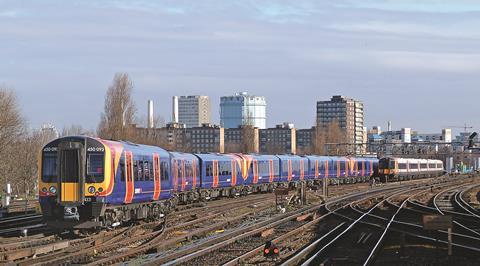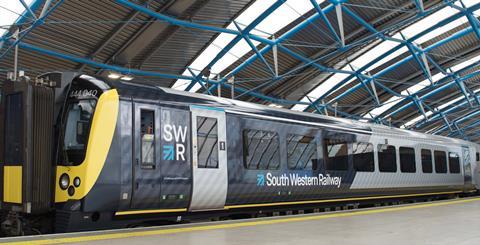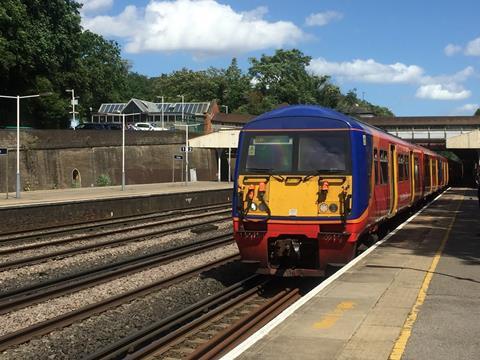
UK: A report issued by Network Rail indicates that the expected drop in commuter and business travel caused by Covid-19 will not be sufficient to remove the need for major infrastructure investment on the South West Main Line serving London Waterloo, including potential resumption of work on Crossrail 2.
Intended to provide strategic advice to government by looking ahead to possible capacity needs in 2050, the SWML Strategic Study — Phase One was undertaken between April 2020 and March 2021 and published in late July, refreshing previous work undertaken as part of the Wessex Route Study in 2015.

The latest study considers:
- the current capability of the network;
- future passenger demand scenarios;
- a road map of interventions to increase capacity to respond to future demand.
The study identifies a number of key constraints affecting the SWML, with its primary focus being the section between Woking and Waterloo and the limited capacity available in the high peak period of arrivals into London between 08.00 and 08.59 on weekdays. It recognises that prior to the pandemic, this corridor was subject to severe overcrowding in peak periods as well as poor operational resilience. This was caused primarily by the flat junction layout at Woking, a 2 min minimum signalling headway and the need for trains to move empty between Waterloo and sidings at Clapham Junction to release platforms at the terminus.
Pandemic effect
In attempting to sketch out a vision for the post-Covid-19 world, the study says that ‘although the pandemic has unquestionably had a significant impact on rail demand, it should be remembered that the SWML was already considerably over capacity, with the resultant impact on performance, and even a long-term reduction in demand is very unlikely to negate the need for any future investment’.
The study offers low, medium and high scenarios for post-Covid demand and compares these against the 2019 baseline for SWML throughput measured in passengers/h. The baseline, high and medium scenarios all forecast demand to be exceeding seating capacity by the mid-2020s. ‘The study has not identified any solutions that could be implemented in such a timescale to mitigate this’, NR warns.
For the medium scenario, NR’s forecasts a 25% reduction in commuting and business travel owing to an increase in working from home, and a similar reduction in leisure trips. This scenario results in an approximate 20% impact on pre-Covid demand. However, there would still be the need for additional on-train capacity by the mid-2020s.

The low demand scenario assumes a 45-50% reduction in commuting and business travel, resulting in a 40% drop in demand. Even in this case, additional capacity would be required by the mid-2030s, the study says.
Medium-term interventions
The study identifies several potential interventions to release additional capacity in the high-peak hour:
- headway reduction to 90 sec between Woking and Waterloo;
- interventions at Queenstown Road to separate out empty train movements;
- completion of the Woking Area Capacity Enhancement scheme, which would include grade separation of the junction with a flyover to segregate trains on the Guildford line and construction of an additional platform at Woking station.
The study suggests that these could release up to eight train paths per hour, but this alone is unlikely to be sufficient to meet demand through to 2050. ‘To provide any additional train paths beyond the eight outlined above would require the delivery of further enhancements, such as Crossrail 2, together with re-modelling of Waterloo throat to provide additional performance and operational robustness by reducing conflicting moves’, NR believes.
Crossrail 2 ‘cannot be overlooked’
Despite the impact of the pandemic on projected demand, the study emphasises the need for progress to be made in developing Crossrail 2, the proposed cross-city tunnel linking Wimbledon with the West Anglia Main Line northeast of London.

The scheme was effectively paused under the funding agreement between the government and Transport for London finalised at the end of 2020, but NR says it remains a critical element in solving the long-term capacity challenge on SWML.
‘The importance of delivering Crossrail 2 cannot be overlooked when considering the current and future strategy of the SWML. Crossrail 2 is a key facilitator to unlocking capacity into London by re-routing a portion of the suburban services using the SWML slow lines into the Crossrail 2 tunnel planned at Wimbledon’, the report says.
By removing these services, seven more trains that currently cross from the slow to the fast lines on their way into London Waterloo could stay on the slow lines throughout, freeing up a significant number of paths for additional fast line services, NR believes.
Quarterly review
In its conclusions, NR warns that returning to the pre-pandemic status quo is not a viable option. ‘The inability to operate a robust service prior to the Covid-19 pandemic shows that the SWML has reached the limits of its operation. Therefore, it is key that as passengers return to the railway and additional services are required, they are reintroduced with resilience mitigations in mind so that the service does not fall back to pre-Covid levels of poor performance.’
Looking ahead, the study recommends that quarterly reviews of SWML demand levels be undertaken to assess how the return of passengers is proceeding against the forecast range of scenarios. NR is also undertaking a second phase of the study to look at demand and network capacity issues south and west of Woking; this would identify where the additional services described in the first phase should operate and whether the network could accommodate them.
Supporting documents
Click link to download and view these filesSouth-West-Main-Line-Strategic-Study
PDF, Size 2.96 mb



